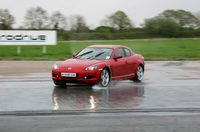Learn to drive in winter from the rally experts

Rally specialist, Prodrive, has launched a winter driving course designed to give motorists the skills to drive safely on snow and ice covered roads this winter.
Using its 26 years’ experience competing in the World Rally Championship, Prodrive has built an all-year round winter driving facility at its private proving ground in Warwickshire, which can simulate driving on ice or snow. It is the same facility Prodrive uses to shakedown the new MINI World Rally Car.
Its new course gives motorists the opportunity to feel what it is like to lose control of their cars and spin in a safe environment, before professional instructors teach them to use the steering, brakes and throttle to control a slide. Prodrive uses specially made low friction surfaces which simulate ice and snow rather than skid cars. This means the course can be undertaken in motorists’ own cars so that they are totally familiar with how their car will react once back on the road, as different skills are required for front, rear and four wheel drive.
The £99 course includes a theoretical section about driving on very low friction surfaces, like snow and ice, highlighting the issue of traction in different cars with front, rear or four wheel drive. But which is better? And why was it that last winter, £50,000 executive saloons were often stranded, while family hatchbacks soldiered on? Damian Harty, Prodrive’s vehicle dynamics specialist, has developed the chassis for the new MINI World Rally Car, he explains why cars react as they do.
“In order to drive, stop and steer a car, the tyre needs to grip the road surface and the amount of grip available depends on a number of factors, including the friction of the road surface; the tyre design; and the amount of weight pressing down on those tyres,” says Harty.
“The surface friction of snow and ice is a fraction of that of tarmac, meaning a tyre can break traction very easily and start to spin. Once a tyre spins, it provides virtually no driving or steering force, allowing the car to slide sideways. An all-wheel drive car has the advantage of sharing the driving force between four tyres, rather than two, so the wheels are less likely to break traction and spin. However, while a four wheel drive may be less likely to get stuck, it does not necessarily make a car any better at cornering or stopping on snow and ice than other cars, as both still have the same four tyres trying to control the car. So while you may feel more safe and secure, this is not necessarily the case.
“Adding downward pressure to any tyre increases grip. This is why F1 cars have wings to produce downforce allowing them to corner incredibly fast. Typical small and medium cars have the engine and gearbox at the front, meaning as much as two thirds of a car’s weight is over the front axle. As a result, the front tyres usually have more grip than the rear, so front-wheel drive cars tend to maintain better traction than rear-wheel drive cars. Larger executive and sports cars struggle in the snow because they spread their weight more evenly, reducing the weight on the driven wheels, meaning modest family hatchbacks are a better option. Other good performers are cars like the Porsche 911 and Boxster, with the engine and gearbox over the driven rear wheels. However, they can lack stability because of the weight at the rear and need careful driving.
“And finally, by far the most important factor, tyre design. This has the biggest single influence on grip and there are three key aspects of a tyre that affect this: tyre profile, tread pattern and rubber compound. While low profile tyres may be great on tarmac; on almost every winter surface, standard profile tyres are better. This is why our rally cars compete with very narrow tyres on snow rallies to help cut through the surface.
“In winter conditions, you also want an ‘open’ tread pattern so that snow doesn’t bung up the tyre, as well as a softer compound of rubber. Standard tyres are excellent in most conditions, but they typically have a tighter tread pattern and the rubber compound is normally designed to provide most grip at temperatures above about 7oC. At lower temperatures, the rubber gets harder and so provides less grip on all surfaces, not just snow and ice.
“Specialist ‘winter’ tyres are designed with a softer compound of rubber and an open tread pattern to disperse snow. Every winter, I fit them to my car, as they are by far the best and safest way to drive on snow and ice and work very well in the wet or on dry tarmac too. Indeed, if I could give two pieces of advice to any motorist, it would be to fit winter tyres, you’ll be amazed at the difference – and learn some car control so you’re not caught out.”
The winter driving course takes place at Prodrive’s private proving ground in Warwickshire and is priced at £99 per person. For full details of dates, please visit prodrive.com.

